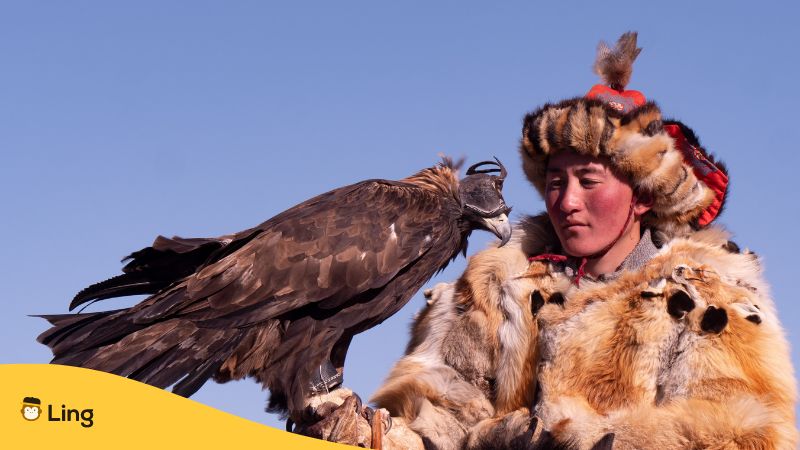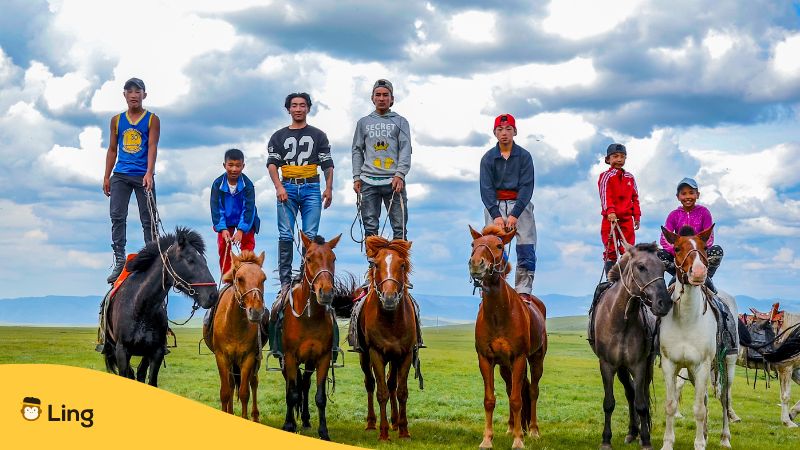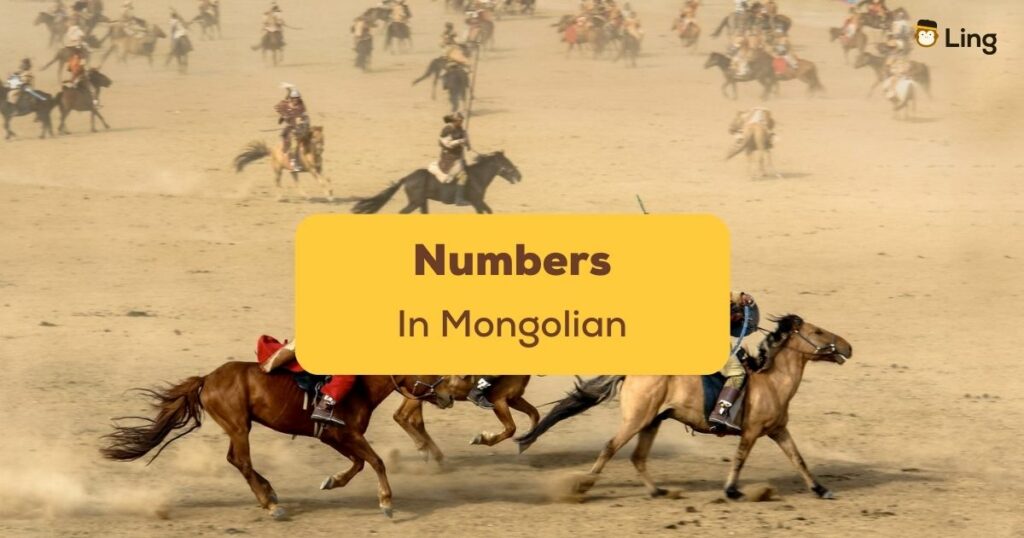Are you planning to go to Mongolia and want to be able to order how many Buuz or Mongolian dumplings you want? You’re in luck! Today we will learn about Mongolian numbers and counting in this beautiful language! Let’s begin!
You may think, “But Miguel, isn’t that easy and very basic to learn?” Yes and no, actually. Numbers or тоо (pronounced as too) are some of the first terms we learn as kids since it’s needed for everyday conversations. Either measuring the amount of milk to make a latte in the morning, choosing the train to head to the office, or memorizing our parking spot in the mall, numbers are all around us (with the voices of the little alien toys in Toy Story😊).
You may take these terms for granted in your language, but have you ever stopped to think about how different cultures count and represent numbers? Let me spark your curiosity and introduce you to the unique and often humorous world of Mongolian numbers and counting.

I can tell you that you won’t find the typical numerals we’re used to seeing in Mongolia. Instead, the Mongolian numeral system is based on the use of dots and lines, which can be quite challenging for non-Mongolians to decipher.
Furthermore, Mongolia was strongly influenced by Russia, so that is another variable that promises to make this whole enterprise a hoot and a half! That’s the reason why some words in Mongolian sound like Russian!
Curious? Come along on a journey of discovery as we delve into the fascinating and sometimes comical world of Mongolian numbers and counting.
Mongolian Script For Numerals
Before diving into the world of numbers and counting in current Mongolian, it is essential to take a step back and mention how numerals are written in the ancient Mongolian script.
Mongolian numerals, also known as vertical script, are a unique way of representing numbers that are still in use today, even though the country officially adopted the Cyrillic script in the 1940s. These numerals can still be found on banknotes, making it essential for travelers and those working with Mongolian currency to be familiar with them.
Here is a list of numerals in Mongolian script:
| Numbers | Mongolian Numerals |
|---|---|
| 0 | ᠐ |
| 1 | ᠑ |
| 2 | ᠒ |
| 3 | ᠓ |
| 4 | ᠔ |
| 5 | ᠕ |
| 6 | ᠖ |
| 7 | ᠗ |
| 8 | ᠘ |
| 9 | ᠙ |
Mongolian Numbers And Counting
Numbers From 0 To 9
Let’s start with the basics – numbers from 0 to 9. It’s good to know the basic numbers as they are used in everyday life; learning them will make it easier for you to understand numbers and start communicating with locals. It’s an important step to get to know the culture and make traveling in the country easier.
| Numbers | Mongolian Script | Pronunciation |
| 0 | тэг | teg |
| 1 | нэг | neg |
| 2 | хоёр | hoyr |
| 3 | гурав | gurw |
| 4 | дөрөв | dorw |
| 5 | тав | taw |
| 6 | зургаа | zurgaa |
| 7 | долоо | doloo |
| 8 | найм | naim |
| 9 | ес | yos |

Numbers From 10 To 99
In the previous section, we covered basic numerals, but what about numbers higher than 9? The system may look daunting at first, but it becomes quite simple once you understand the pattern. Here’s a list of numbers from 10 to 20 in Mongolian and their English pronunciations:
- 10 – арван (arvan)
- 11 – арван нэг (arvan neg)
- 12 – арван хоёр (arvan khoer)
- 13 – арван гурав (arvan gurav)
- 14 – арван дөрөв (arvan dorov)
- 15 – арван тав (arvan tav)
- 16 – арван зургаа (arvan zurgaa)
- 17 – арван сем (arvan sem)
- 18 – арван наян (arvan nayan)
- 19 – арван ес (arvan es)
As you can see, for example, the number 14 is formed by adding the numbers 10 and 4 together. It is important to notice that -н is always added to the 10’s digits.
To help you form even higher numbers, the next decimals in Mongolian are pronounced as follows:
| Numbers | Mongolian script | Pronunciation |
| 20 | хорь | hor |
| 30 | гуч | guch |
| 40 | дөч | duch |
| 50 | тавь | taiv |
| 60 | жар | jar |
| 70 | дал | dal |
| 80 | ная | nai |
| 90 | ер | yer |
| 100 | зуу | zuu |
From here, it’s just a matter of combining the numerals we’ve already learned to form numbers in the tens and one’s place. For example, 43 is дөчин гурван (döchin gurvan), and 77 is далан долоон (dalan doloon).
It’s important to note that while the pattern is similar to the English way of counting, the pronunciation can be quite different, and it’s always recommended to check the pronunciation with a native speaker.
There are a few numbers that usually trick who is trying to learn them, so here is a list of these little pranksters side-by-side so you can see the difference:
| 2 (хоёр) | 20 (хорь) |
| 3 (гурав) | 30 (гуч) |
| 4 (дөрөв) | 40 (дөч) |
| 5 (тав) | 50 (тавь) |
| 6 (зургаа) | 60 (жар) |
| 7 (долоо) | 70 (дал) |
| 8 (найм) | 80 (ная) |
| 9 (ес) | 90 (ер) |
Numbers Up To 1000
Not so hard, right? Well, for numbers in the hundreds, the only change you need to introduce to your numbers is the word indicating the correct hundred.
- 100 – зуун (zuun)
- 200 – хоёр зуу (khoyor zuu)
- 300 – гурван зуу (gurvan zuu)
- 400 – дөрвөн зуу (dörvön zuu)
- 500 – таван зуу (tavan zuu)
- 600 – зургаан зуун (zurgaan zuun)
- 700 – долоон зуу (doloon zuu)
- 800 – найман зуу (naiman zuu)
- 900 – есөн зуу (yesön zuu)
- 1000 – мянган (myangan)
So, let’s now look at one example. Imagine you wanted to say the number 694. How would you say it? So let’s break it down, 600 is зургаан зуун (zurgaan zuun), 90 is ерэн (yeren), and 4 is дөрөв (döröv), so the final number would be:
зургаан зуун ерэн дөрөв (zurgaan zuun yeren döröv)
If you want to learn how to pronounce several numbers, check out this perfect video!
Other Number-Related Vocabulary
| English | Mongolian | Pronunciation |
| Add | Нэмэх | Nemekh |
| billion | тэрбум | terbum |
| Divide | Хуваах | Khuvaakh |
| Dozen | Арваад | Arvaad |
| Hundred | Зуун | Zuun |
| Infinite | Хязгааргүй | Khyazgaargüi |
| Million | Сая | Saya |
| Multiply | Үржүүлэх | Ürjüülekh |
| Negative | Сөрөг | Sörög |
| Portion | Хэсэг | Kheseg |
| Positive | Эерэг | Eyereg |
| Subtract | Хасах | Khasakh |
| ten | арав | arav |
| Thousand | мянга | myanga |
| Total | Нийт | Niit |
| trillion | их наяд | ikh nayad |
| Value | Үнэ цэнэ | Üne tsene |

Ordinal Numbers In Mongolian
Ordinal numbers are said as follows:
| English | Mongolian | Pronunciation |
| First | Эхлээд | Ekhleed |
| Second | Хоёрдугаарт | Khoyordugaart |
| Third | Гуравдугаарт | Guravdugaart |
| Fourth | Дөрөвдүгээрт | Dörövdügeert |
| Fifth | Тавдугаарт | Tavdugaart |
| Sixth | Зургаа дахь | Zurgaa dakhi |
| Seventh | Долоо дахь | Doloo dakhi |
| Eigth | Найм | Naim |
| Nineth | Ес | Yes |
| Tenth | Аравдугаар | Aravdugaar |
| Eleventh | Арван нэгдүгээр | Arvan negdügeer |
| Twelfth | Арван хоёрдугаар | Arvan khoyordugaar |
| Thirteenth | Арван гурав дахь | Arvan gurav dakhi |
| Fourteenth | Арван дөрөв | Arvan döröv |
| Fifteenth | Арван тав дахь | Arvan tav dakhi |
| Sixteenth | Арван зургаа дахь | Arvan zurgaa dakhi |
| Seventeenth | Арван долдугаар | Arvan doldugaar |
| Eighteenth | Арван найм дахь | Arvan naim dakhi |
| Nineteenth | Арван есдүгээрт | Arvan yesdügeert |
| Twentieth | Хорьдугаар | Khoridugaar |
Recap
So what have we learned today? How to count from 0 to basically infinite! We even learned some words to support our counting efforts. The next step now is straightforward: continue learning Mongolian!
This is where you pull up your sleeves and get to work. The key is easy, practice, practice, practice! To help you with that, I want to present a tool that will simplify the learning process.

Learn More Than Just Numbers In Mongolian With Ling App
If you’re like me and you’re eager to learn a new language, then definitely check out the Ling app, a language learning application that will teach you everything you need to know about over 60 languages worldwide. Expect to learn through games, puzzles, and more fun ways! Start now and download the Ling app from the Play Store or App Store!






















